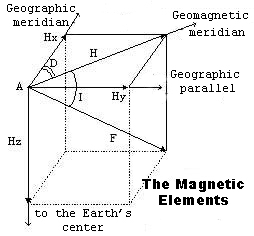|
|
Magnetic Measurements >
Magnetic Field Elements
Magnetic Field Elements
|
| |

|
Main characteristic of the Earth's magnetic field, just like as it is for all magnetic fields,
is intensity F or its components. Usually Cartesian rectangular coordinates are used
resolve vector F into components, where x-axis is oriented towards the direction of the geographic
meridian northward, ó - towards the direction of the geographic parallel eastward, z - is oriented downward to
the center of the Earth.
|
| |
Origin of coordinates is placed to the observation point.
The projection of vector F onto horisontal plane is called horisontal intensity H.
Trimetric projection onto the x, y and z axes gives us north Hx, east Hy
components of H and vertical intensity Hz.
Vector F belongs to the plane of the magnetic meridian, the angle between the geographic
and magnetic meridians is called declination D. Finally, the angle between the horisontal plane
and the direction of vector F is designated as inclination I. Positive D direction
is to the East, positive I direction is down (takes place in nothern hemispere).
F is an international symbol for total field intensity vector, sometimes it is also signed as Ò,
but it's also the sign for the module of vector F. Declination D, inclination I,
horisontal intensity Í, vertical intensity Hz, north Hx and east Hy
components are designed as the magnetic elements.
Observations show, that values of each element of the Earth magnetic field are permanently changing.
These changes occur from hour to hour, from year to year. Such changes are called variations of the magnetic field
elements. When observing these variations for a short period of time (daily) it could be seen that they
are periodic, but periods, amplitudes and phases are extremely diverse. But in case of long-term elements observations
(several years) with annual means determination, it’s easy to estimate that annual means also change but in
monotonous way, and periodicity occurs only in a very long-termed observations (about decades and hundreds of years).
The slow variation of the Earth magnetic field elements is referred to as secular variation;
its magnitude generally is tens of gammas a year. Secular variations of elements are driven by the changing pattern
of motion in the core and is caused by the same reasons as the Earth’s magnetic field is.
Change in the average annual values of the particular element within a year is called
secular variation.
Fast periodic variation, highly variable in amplitude, have their source in electrical
current of upper atmosphere.
The data on fast variation of the Earth’s magnetic field in hourly and minute values are represented
on the site of the World Data Center for Solar-Terrestrial Physics.
|
|


